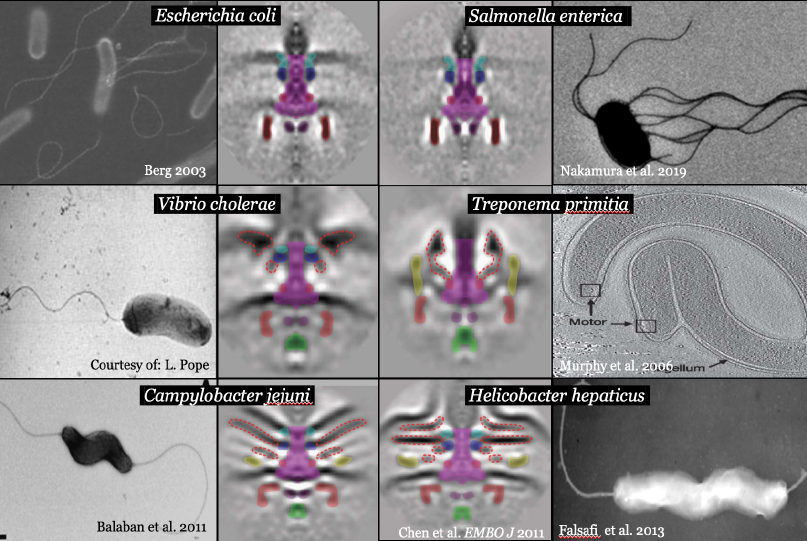Welcome to the Nirody Lab!
We study the
physics of how biological systems interact with their environments, as well as the role of these interactions in shaping organismal morphology and behavior.
We are organismal biophysicists & integrative biologists, and we use a range of theoretical and empirical (laboratory + field) techniques to answer questions that sit at the intersection of
behavior, biophysics, and evolution.
We work on problems across organismal systems and levels of biological organization. While the underlying mechanisms (and the techniques we use to study them) may vary as we shift our focus from
molecular motors to bacteria to animals, the larger questions we are fascinated by remain the same!
- How do biological systems sense and respond to mechanical stresses in complex environments?
- In what environments do adaptive mechanics improve performance?
- How do flexible locomotive strategies affect the evolution of biomechanical structures?

The bacterial flagellar motor and other molecular machines.
The bacterial flagellar motor (BFM) powers motility in over 80% of known bacterial species. Our lab asks both mechanistic and evolutionary questions about these nanomachines: How do molecular motors, like the BFM, convert electrochemical energy into mechanical work? What adaptive mechanisms at the molecular level allow bacteria to navigate such a wide range of environments? What selective pressures have shaped the diversity in flagellar motor structure across bacterial lineages over evolutionary timescales? We use both theoretical and experimental tools, and are particularly excited about designing and building novel biophysical setups to work with a variety of non-traditional organisms.
Relevant papers | Image: EMBO

Microbial motility and mechanics.
Flagellated motility is used by a huge range of bacterial species that live in and move through a huge range of enironments, from marine microbes to residents of the human intestine. Accordingly, flagellar number and organization can vary wildly both inter- and intraspecifically. We are interested in investigating the link betwen flagellar morphology, performance, and bacterial fitness in various environments. How does flagellar number and organization impact various swimming metrics (e.g., speed or chemotactic ability)? How do mechanically-structured environments affect motility patterns? What external parameters favor higher or lower flagellar numbers, and which are selected for in different environments?
Relevant papers | Image: CDC

Biomechanics and behavior in panarthropods.
Panarthropods are a stunningly varied group, including insects, crustaceans, tardigrades, and centipedes. We are excited both about asking questions on the origin and evolution of panarthropod locomotion, as well as understanding how to better design simple, small circuits that can control multiple limbs in complex, variable terrain. We integrate fieldwork alongside lab experiments, as well as work with collections at the Field Museum. Current areas of interest in the lab include investigating comparative jumping biomechanics and leg morphology in salticids (jumping spiders), and characterizing conserved and variable features in walking coordination across a range of species from tardigrades to flies.
Relevant papers | Image: L. Duran

Movement through complex, changing environments.
To survive and reproduce, organisms must often nagivate spatially complex and temporally dynamic terrain. The impact of environmental variability on organismal performance is of particular interest given the anthropogenic effects like climate change and urbanization. Our lab is broadly interested in how organisms sense and respond to mechanical cues from their environments. We've worked with a range of systems across scales, from phototaxis in unicellular organisms to complex locomotive behavior in vertebrates (e.g., multi-modal strategies for water walking in geckos, shown above). We are also interested in how flexible locomotive strategies affect the evolution and diversification of biomechanical structures.
Relevant papers | Image: P. Jennings




